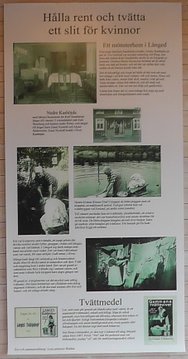Lena Grönlund and Jan Hellers is looking at a series of photos starting in the end of the 1900th century. Patrik Olofsson collected this series. He has done two more, all of them the start of associations and memories among the visitors.
Women's hard work with washing was the theme for our first exhibition. It was not until the 1960th that washing machines became more frequent. Until then washing of all textiles was done in lakes or rivers, or in water from the well - or perhaps never done at all. If water was scarce it was saved as drinking water to humans and animals.
Galleri Olika is a NGO-gallery driven on non profitprinciples. Members pay a yearly tribut which pays the premises and insurance for this. Exhibitors have to keep the gallery open themselves. You can read more about this gallery here. The gallery has opened in April 2001 and is still going - a small miracle in such a small place as Dals Långed.
In our second exhibition in November 2015 was the theme the business activity in Långed and Långbron since 1800th century. I had sewn 7.2 meter main street and a parallel street to scale to organize all papers with photos showing houses and all facts know to us about these activities.
We plan to write chapters about the business activities in our second book, and probably also about women's work. We got many interesting histories during our exhibitions and want to document these for future.
Curator for the two exhibitions was Lena Adamina Waldau, who also took these photos and wrote the texts.
In many homes in areas with paper mills there still are carpets and blankets made of the matted wool felts that the mills used when pressing the water out of the fibers to make pulp. It was heavy work washing these big felts before cutting them into strips for weaving. Naturally the washing had to be done in rivers or lakes, which in Sweden means farily cold water the year around.
